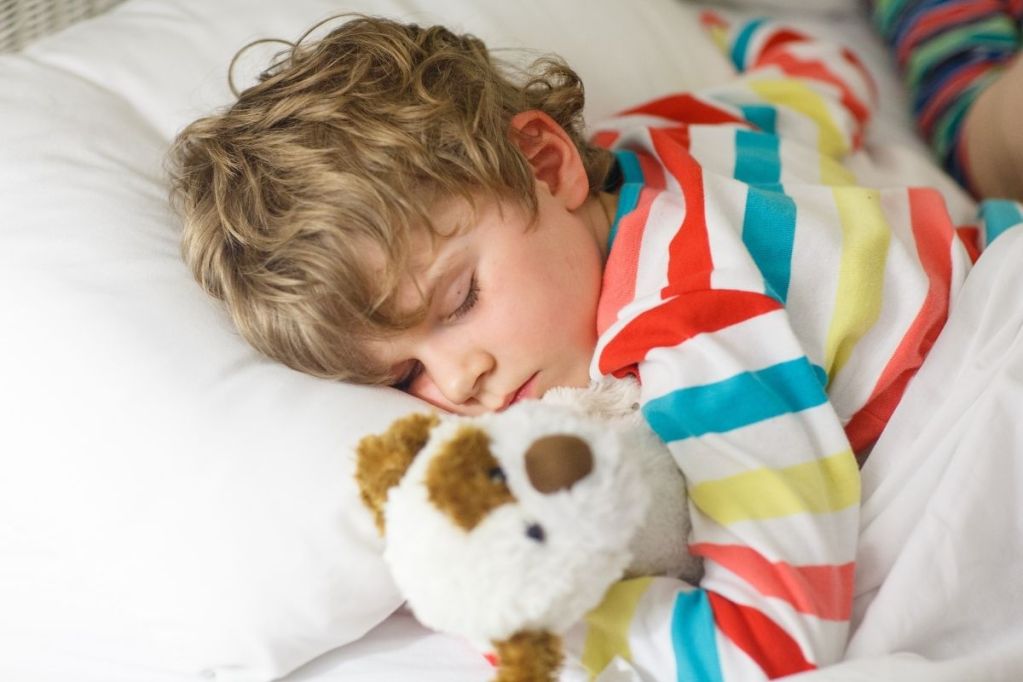
Getting a good night’s sleep isn’t just important for your toddler but for everyone else in the house as well. Having a well-rested household means everyone functions better and is in a better mood. If your toddler takes forever to fall asleep, that can affect everyone’s sleep. Fortunately, there are some bedtime hacks and tips to get your toddler to sleep that can help.
Setting up the right timing and routine and sticking to a consistent schedule make a big difference in deterring kids from getting out of bed to ask for a snack, water, or song every few minutes. When toddlers know what to expect at bedtime, they’re much more likely to have an easier time drifting off to dreamland. Read on for our eight best tips to get a toddler to sleep.

8 tips to get toddlers to sleep
1. Time bedtime perfectly
If you start trying to put your toddler to bed for the night at 4:00 p.m., you’ll probably have a very long and terribly frustrating bedtime process. It’s the same if you don’t start until 11:00 p.m. In general, you can’t force a bedtime. It’s best to make bedtime the time that your toddler naturally gets sleepy but isn’t yet overtired. You can control when your toddler gets sleepy by letting them nap or not and when you schedule the nap, but by the end of the day, you pretty much have to go with the flow.
2. Keep bedtime consistent
While you want to go with your child’s natural rhythm as we just discussed, once you know the time your child typically gets drowsy, pick that time on the clock to be bedtime every night. Staying up an hour later one night and an hour earlier the next won’t encourage a successful bedtime routine with minimal resistance.
3. Time dinner appropriately
Does your child come out of bed asking for a snack? Make sure they haven’t eaten too early so that they’re hungry again after the bedtime routine. Time dinner to be over an hour or less before bedtime to avoid this issue. The digestion will also help make them sleepy.
4. Wind down
Kids shouldn’t go straight from running around outside into bedtime. After dinner, wind down with books, chatting about their day, quiet music, stretching, or even breathing exercises or meditation. This isn’t a good time for tablet time since the light can mess with their circadian rhythm. Bedtime starts long before bedtime, prepping the mind to be quiet and restful.
5. Set up the space for success
Make sure your child’s bedroom encourages sleep. You want them to feel safe and calm, so some soothing music or a white noise machine can help. Some fairy lights or a night light that projects stars onto the ceiling can also make a child less scared of the dark. You can even put a lavender spray or sachet under the pillow to encourage sleep. Invest in blackout curtains so natural light doesn’t keep your child awake or wake them up too early (they might also be scared of the dark out the window, so keep the curtains closed).
6. Stick to a consistent routine
The repetition of the bedtime routine should cue your child’s brain every night that it is time for bed. For most kids, this involves brushing their teeth, washing their face, going potty, and then once in their room, putting on PJs and having some books read aloud to them. You may also add rubbing their back or another soothing and calming part of the routine after story time. Even the number of books and length of the stories should be consistent.
7. Attend to every need preemptively
If you are potty training or post-potty training, you might not let your child have unlimited water overnight. In this case, having their last drink of water should be part of the bedtime routine. Make sure going potty is one of the last parts of the routine before heading to the bedroom so they can’t come out saying they have to go again. Whatever they come out asking for nightly, attend to it right before going to bed to avoid the request coming after bedtime.
8. Leave them with a recording still entertaining them
Your child likely misses you once you leave. Record your voice telling them a story on an old phone (or a tape recorder, tablet, or whatever you have available), and let the recording of you telling them more stories continue as you leave. They can fall asleep to your voice without you needing to be there. If you don’t want to record or don’t have a device for that, there are many audiobooks, bedtime podcasts, and pre-recorded short stories for kids (many specifically for bedtime) that you can leave playing.

Why sleep is so important for toddlers
Not only is sleep important for toddlers in ensuring they are in a good mood, and not tired and cranky, but adequate sleep is also crucial for a toddler’s mental and physical development. Sleep, or lack thereof, can affect how a toddler learns, behaves, and functions either within a group or on their own. Children who aren’t getting enough sleep may often exhibit disruptive behavior like tantrums or lack the ability to pay attention. Sleep plays a role in a toddler’s physical growth and development as well, and according to the Mayo Clinic, lack of sleep “reduces the immune system’s ability to defend against colds and the flu.”
With these eight tips to get a toddler to sleep, your child will be prepped for sleep and be less likely to resist bedtime so they stay in bed.



